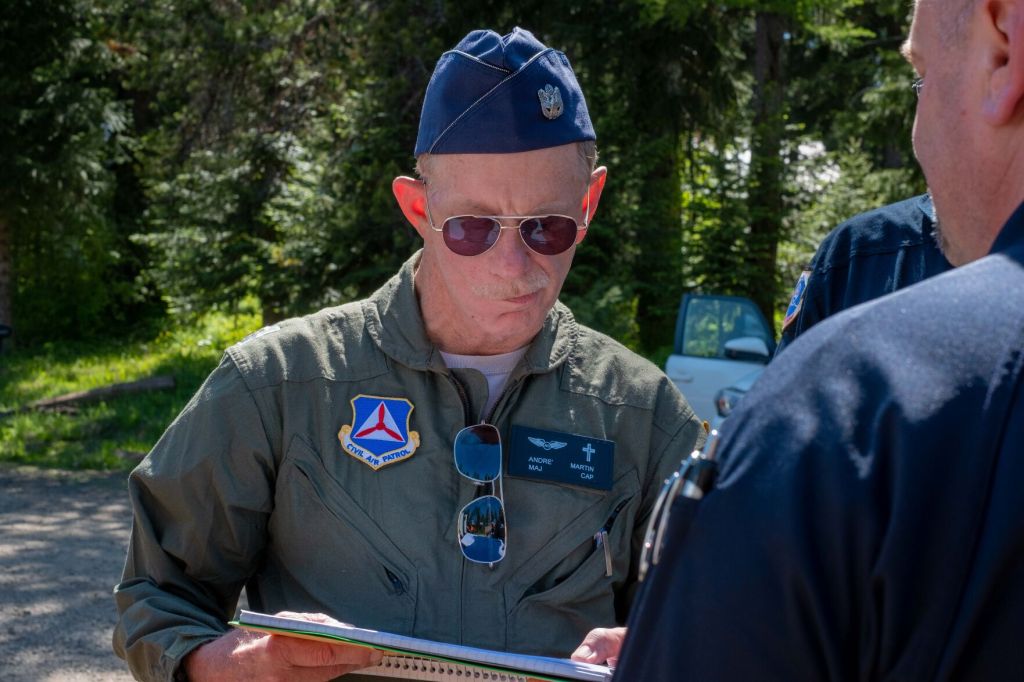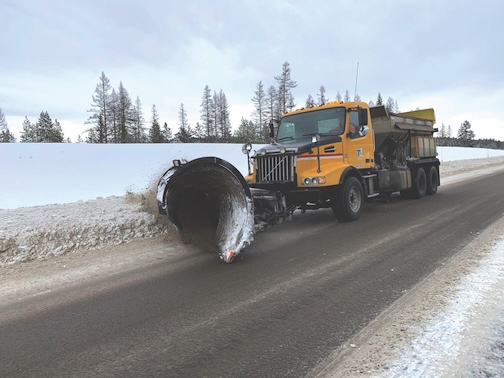Eastern Oregon search and rescue teams train near Weston
Published 10:00 am Monday, June 5, 2023

- Maj. Andre Martin, a chaplain in the Civil Air Patrol, looks over his assignment before boarding his plane Friday, June 2, 2023, at the three-day search and rescue simulation training at Camp Meadowood Springs near Weston.
WESTON — Search and rescue volunteers and sheriff’s staff gathered Friday through Sunday, June 2-4, near Weston for an annual regional search and rescue training. The event brought together more than 60 staff from Gilliam, Union, Umatilla, Wallowa and Harney counties.
Trending
“We’ve got a fairly simple assignment for them this year, though those working the training don’t know it,” said Umatilla County Sheriff’s Sgt. Dwight Johnson, who was overseeing the training.
Umatilla County Sheriff’s Capt. Sterrin Ward said the scenario for the 2023 Eastern Oregon Search and Rescue Regional Training had participants searching for a 1970s Cessna airplane reported as an overdue aircraft. The plane carried two confirmed people and possibly a third who had been flying over the Weston area to search for hunting spots. With radar down, search and rescue members had little information about the exact location of where the plane could have gone down.
The training uses realistic obstacles to present challenges to searchers, such as locked gates or challenging terrain, according to the sheriff’s office. Participants also are not aware of the scenario details ahead of time, according to the sheriff’s office, to allow for the discovery of information in a more realistic way.
Trending
Thankfully, Ward said, the organizers of the training provided an extra clue — a staged phone call from an individual who was illegally logging in the Weston area when he overheard a loud motor-like sound followed by a crash near Couse Creek Road.
“That call sounds like it could credibly be our crash,” Johnson said. “You know, our pilots like to hunt up here, so it’s not out of the ordinary that they might have made a flight plan to come up here.”
The Umatilla County Sheriff’s Office “activated” its search and rescue team to search the site, and the training began. Should an event like this actually happen, Johnson said, the sheriff’s office in the relevant jurisdiction would activate its search and rescue unit.
“It gives an opportunity for us to play out what is a possible scenario and sort through the organized chaos of a response,” Ward said. “Normally you wouldn’t have this many people on a single operation, so that contributes to the difficulty of organizing and getting everything right.”
The “organized chaos” Ward referred to was readily visible after those participating in the training received their briefing as ground searchers, logistics, drone and Civil Air Patrol elements scrambled to get organized and begin their search for the simulated downed aircraft.
“In a real situation, we want to avoid the confusion and missteps that can arise,” Johnson said. “We want to use these lessons and build teams so that when we have an actual incident, everyone can sort through the chaos and know exactly where they need to be.”
Participating in the search
Marcus Bianco, 38, of La Grande, has been participating in search and rescue operations since 2019 when he talked with a coworker who was active in SAR and realized he might have the skills to participate.
“I felt I had transferable skills from what I like to do in my free time and what I do for work,” Bianco said. “I work for the Oregon Department of Fish and Wildlife and I’m a hiker, camper.”
Bianco said combining his love for the outdoors with the potential to save lives through participating in SAR as a ground searcher allows him to do what he loves but with a mission.
“I love working in these small, rural counties, everyone wears so many hats and participates in a bunch of different teams,” he said. “I felt I could contribute best with ground-search with my skills.”
Ground teams, all-terrain vehicle teams and a drone team worked June 2, but mock weather reports kept the Civil Air Patrol grounded. The patrol stationed two aircraft at the Eastern Oregon Regional Airport in Pendleton to participate in the search. While the Civil Air Patrol did not fly that first day, it would on the second.
“When we get activated, like we did here, we stand up our overhead team and then we notify our crews, they get scrambled to either go look for a signal from the downed aircraft, or we keep them up there to facilitate radio communication for SAR,” Civil Air Patrol Capt. Patrick Wineman said. “We’ve also begun doing more aerial imaging, and we’ll be doing some of that here.”
Searchers during the first day discovered “plane” wreckage — a blue shirt and glove, but no passengers, according to the sheriff’s office.
Finding the plane, occupants
The Umatilla County Sheriff’s Office reported the second day of the 2023 Eastern Oregon Search and Rescue Regional Training ended with searchers rescuing three survivors, recovering a dead pilot and locating a second plane wreckage.
The morning started earlier with a briefing for all involved in the search and assignments given to specific search teams, including ground search teams, utility and all-terrain vehicle teams, K9 teams, drone teams and the Civil Air Patrol.
“Again, the training scenario was designed to be played out in real time with searchers unaware of details until discovered,” according to the sheriff’s office.
At around 11:45 a.m. June 3, a K9 team located two survivors (played by real people) with some mock minor injuries and diabetic issues.
Searchers soon afterward found the first plane’s pilot, who had some critical medical issues requiring special extraction from the scene. Survivors provided vital information that their plane had collided with another small plane. That changed the objectives of the mission to begin searching for a second plane and missing pilot.
Civil Air Patrol launched its two planes from Pendleton to scan the search area from above, and all searchers focused on the new objectives. By the end of the day, according to the sheriff’s office, searchers discovered the “plane wreckage” and the “deceased pilot.”
Throughout the second day, participants had the opportunity to communicate and work together to coordinate a complicated search using different skilled teams based on the needs of the mission as it evolved.
The regional training’s final day, June 4, began in the morning with an after-action review to go over what happened, what worked and what needed to improve.
Ward also said there was a final training event the last day — the Oregon Army National Guard flew in a Black Hawk medic crew.
“Search and rescue members learned about the availability and capabilities as a resource to assist with search and rescue extractions and medical evacuations,” she said.
It is a matter of life and death, Johnson said, that SAR professionals and volunteers understand their roles to facilitate quick and efficient responses to an emergency.
“A lot of the time when we’re responding to someone missing,” Johnson said, “we don’t know anything about what kind of physical condition they’re in. People’s lives can actually depend on how fast and effective these responders are.”









